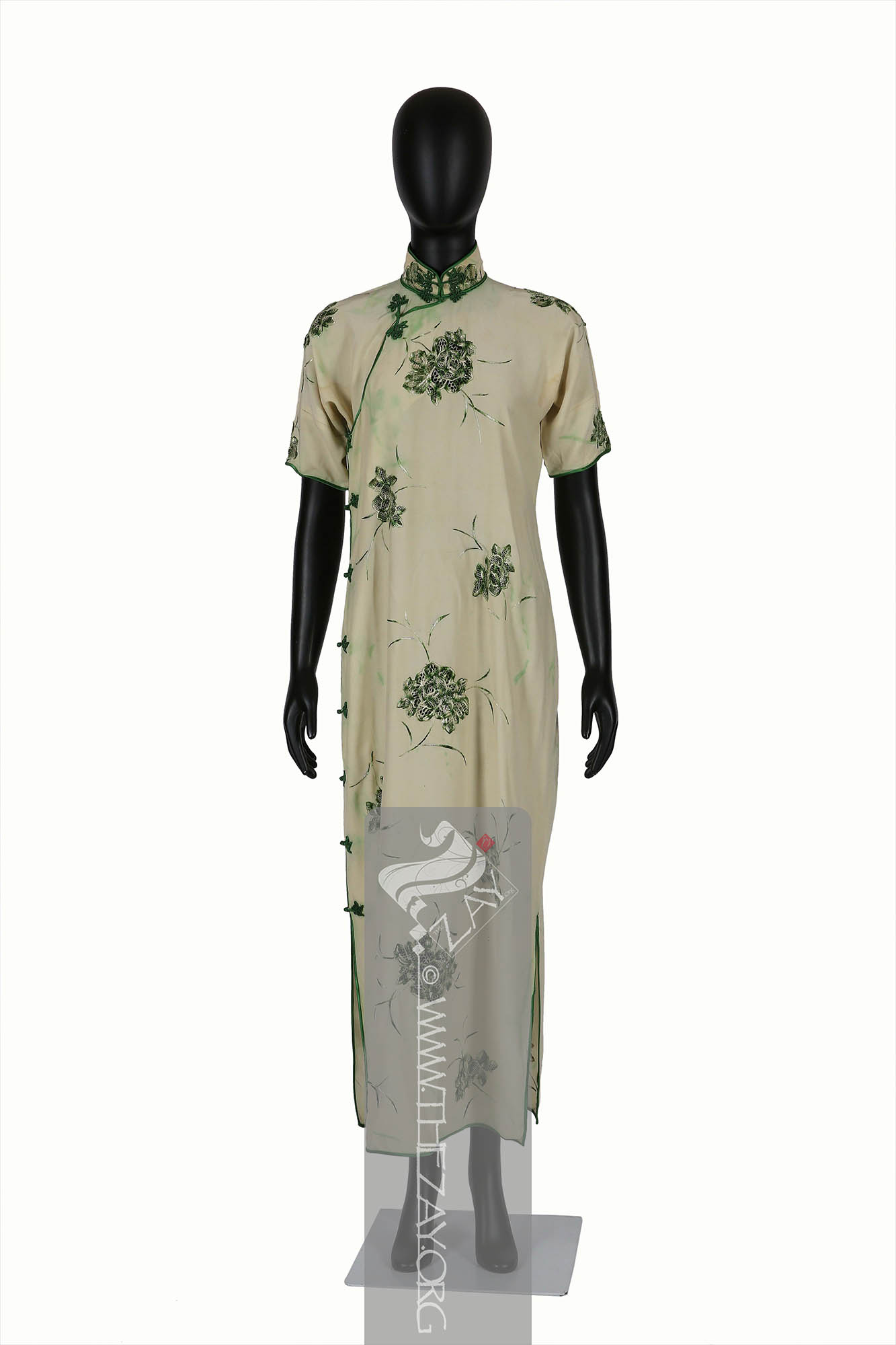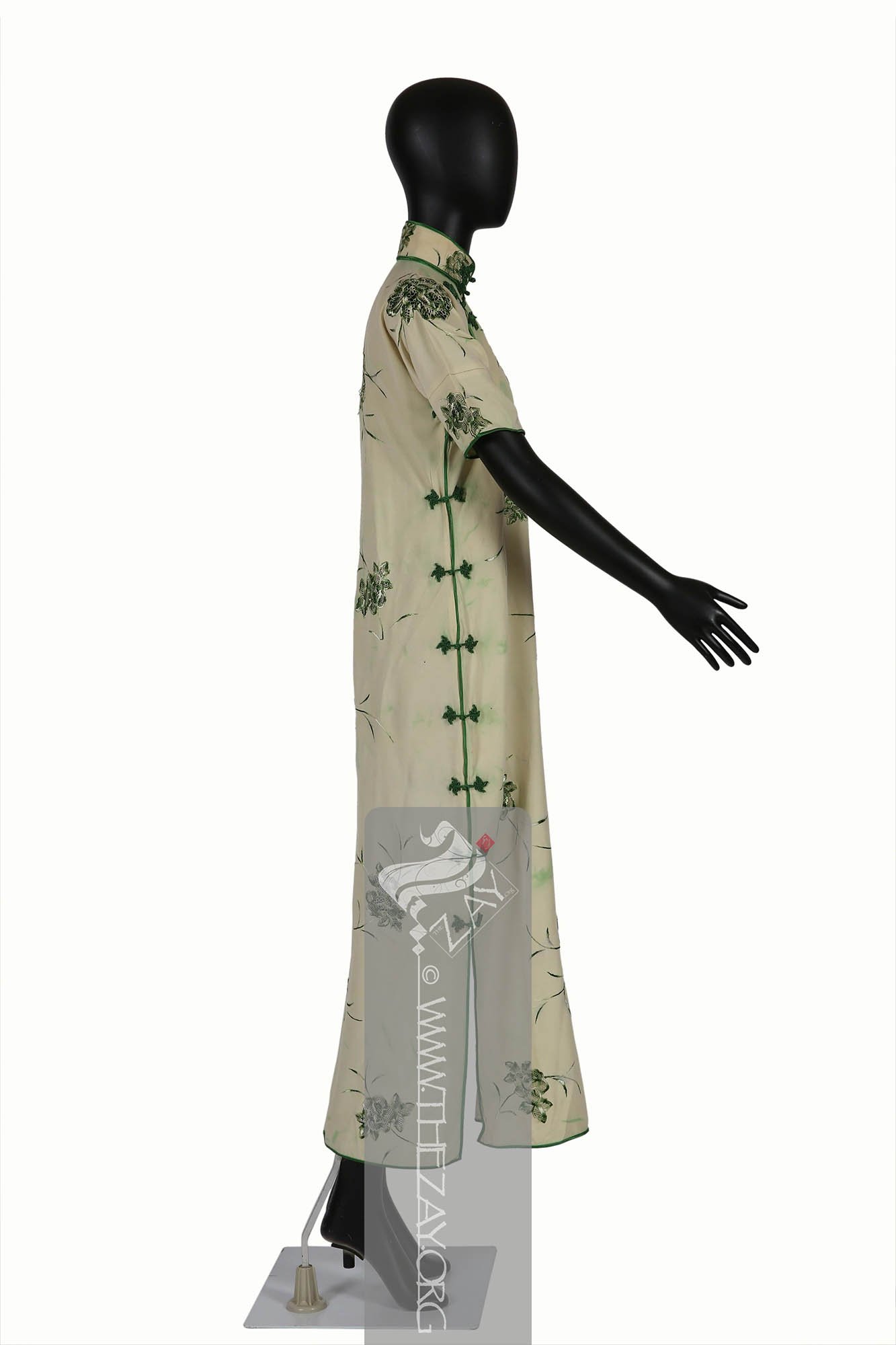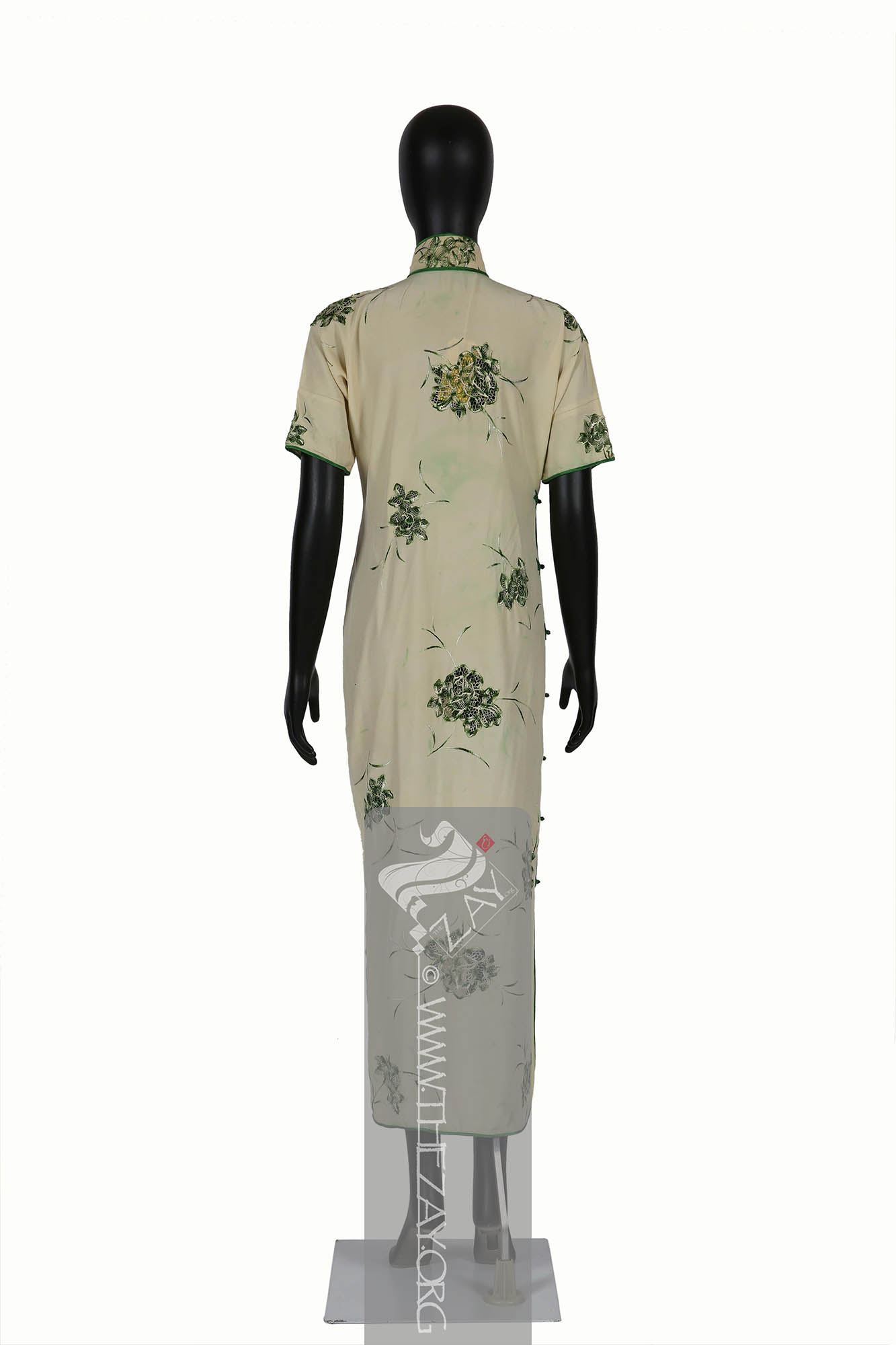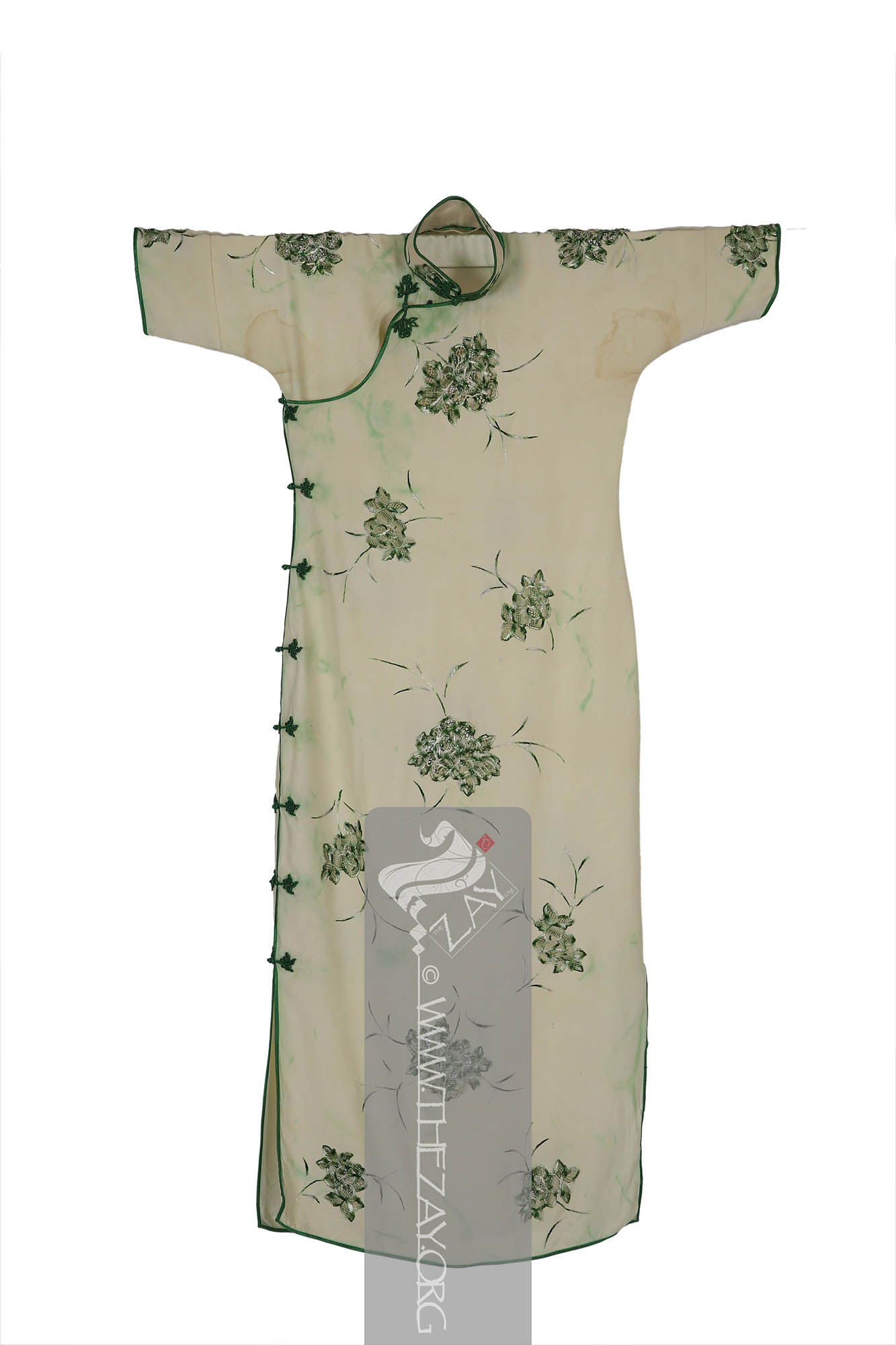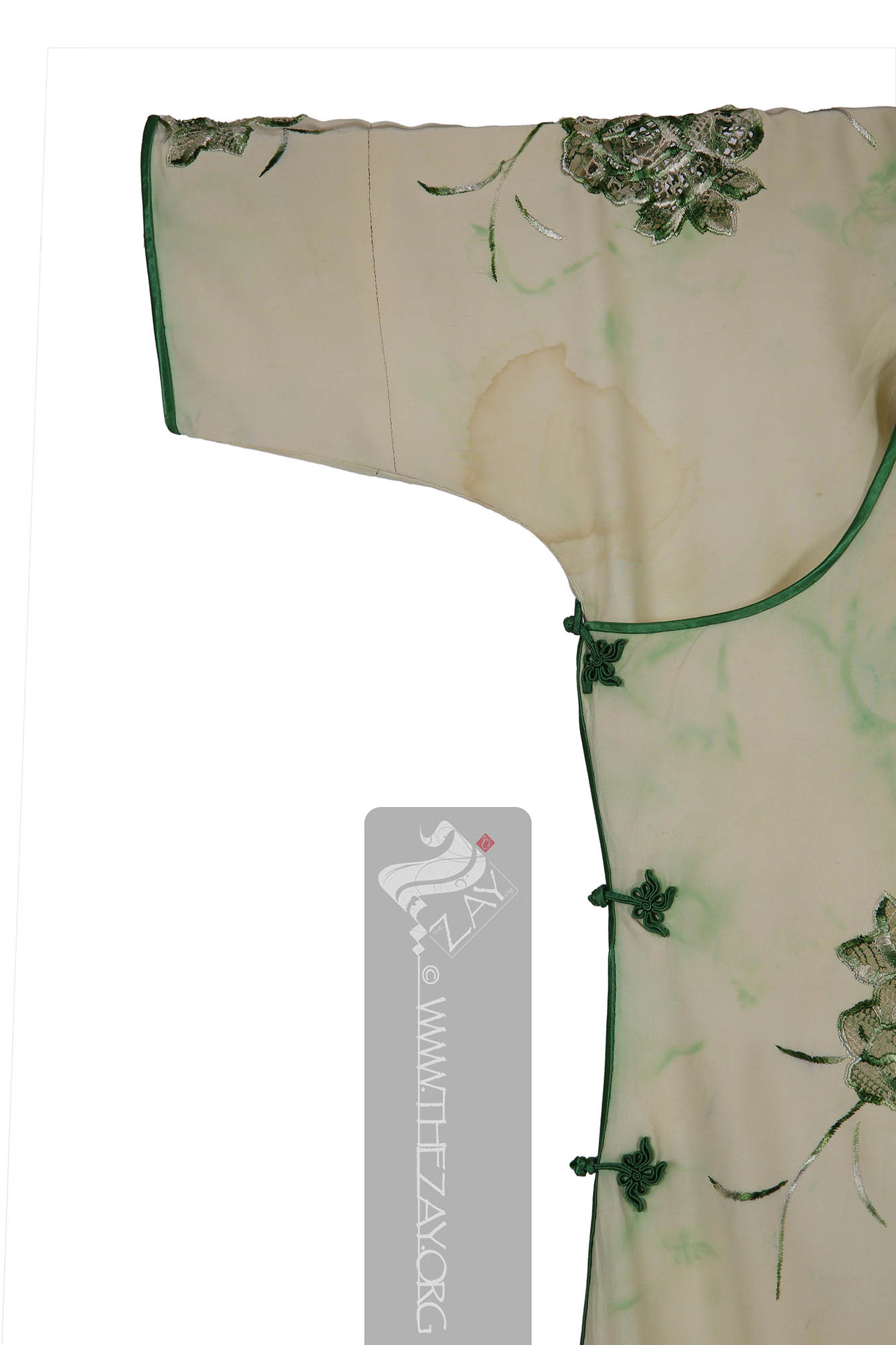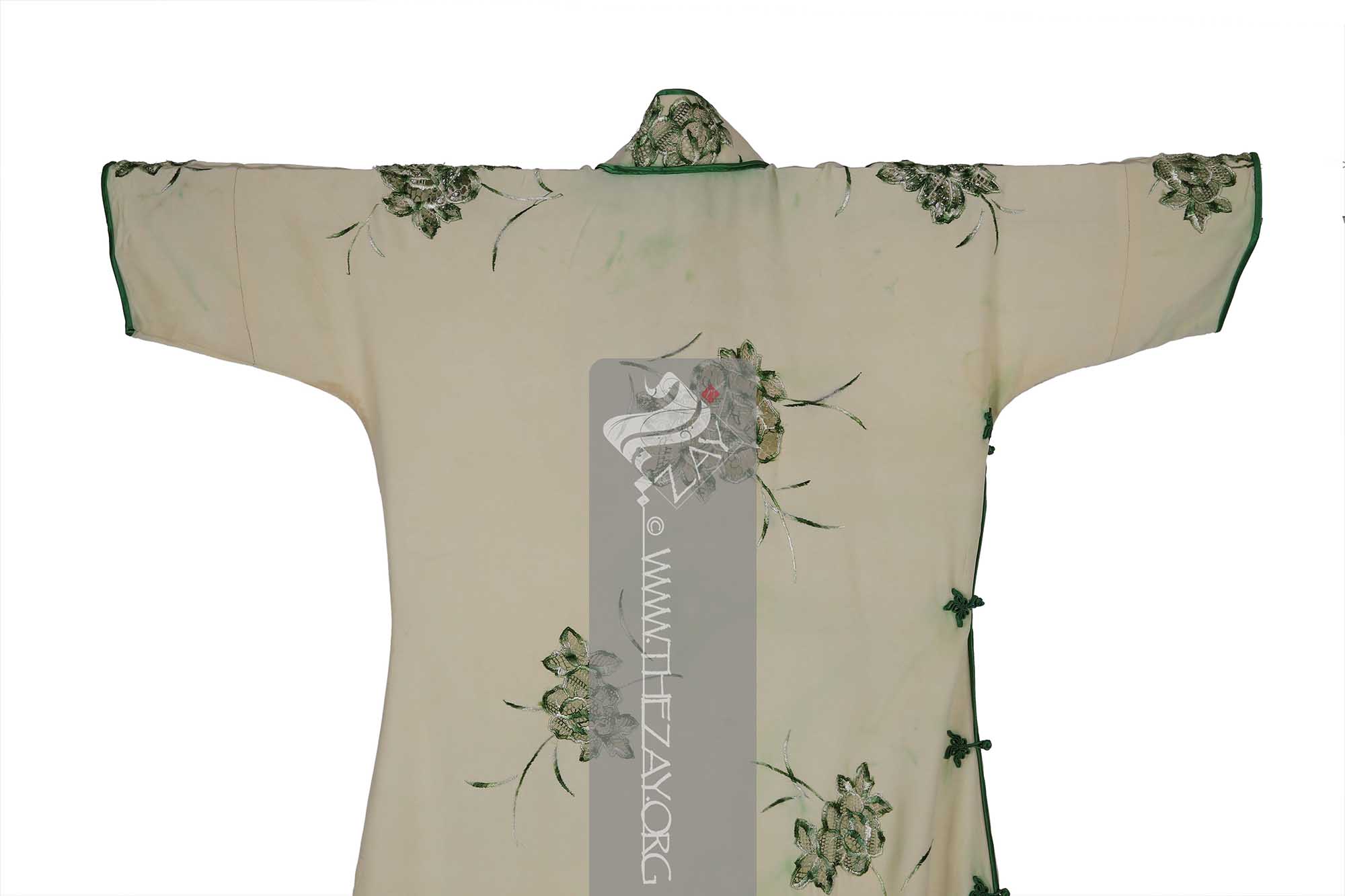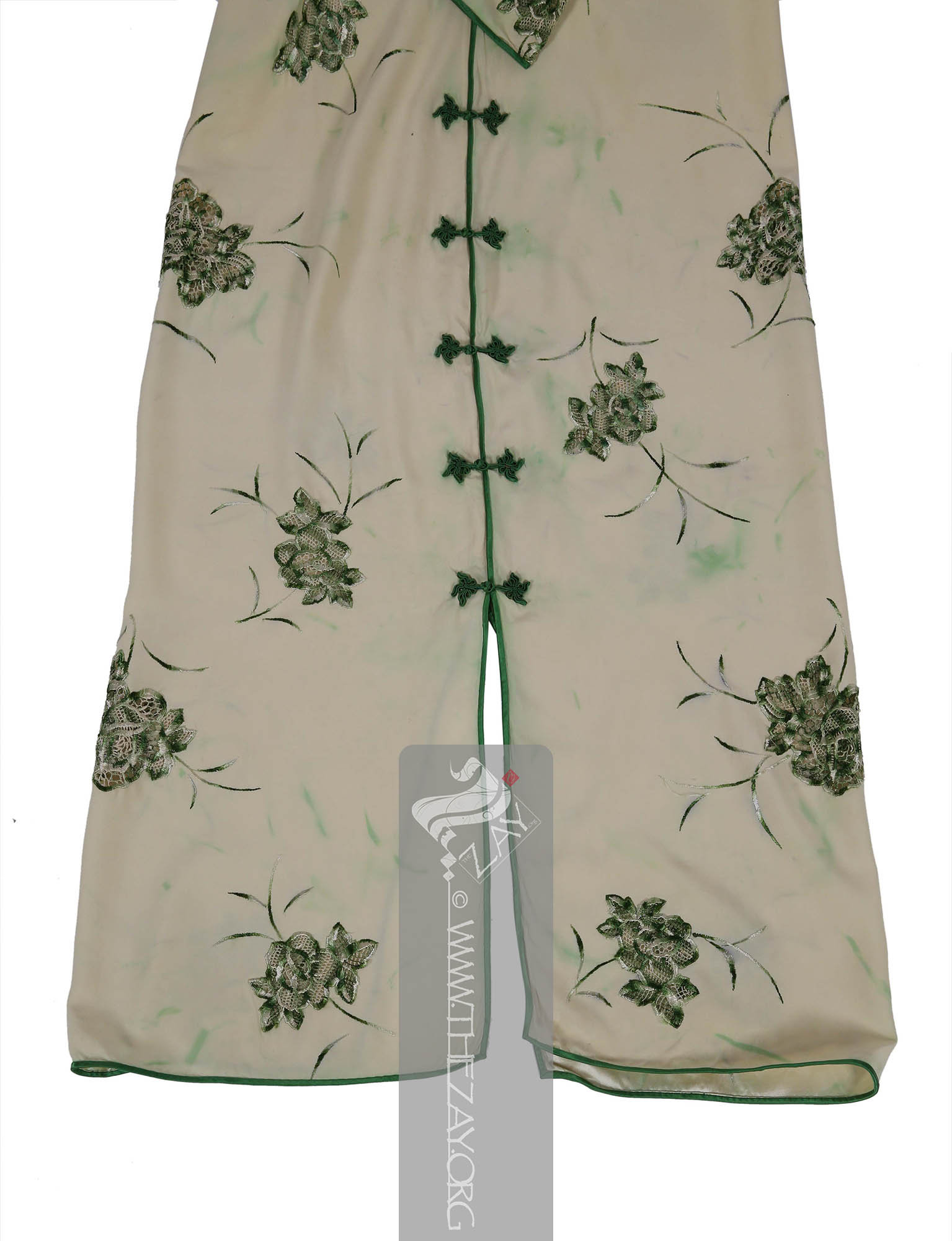Object HistoryThis elegant dress (
qipao
Qipao: (Synonym – cheongsam), meaning ‘Banner robes’ were originally traditional Manchu long loose robes worn over trousers. In the early 20th century, it morphed into its present form and incorporated Western style in the 1920s and became interchangeable with a cheongsam. ) was gifted to Dr. Reem El Mutwalli from Athbah Al Kalamchi, her sister-in-law. It was originally an heirloom handed down from her grandparents and belonged possibly to the period between c.1930-1950.
Athbah Al Kalamchi was born in 1959 in Lebanon and grew up in Iraq. She graduated with BS in economics from Baghdad University. Married to an Italian she moved to Italy in 1990 where she continues to reside with her only son Omar. Athbah’s maternal grandfather Dhafir Rashid Al Zahawi had professional ties in China and the Far East. He constantly travelled back and forth to China and this article was brought as a gift for a family member on one of his several trips before the Chinese Civil War of 1945 -1949.
Object Features This is an ivory and green (
crepe
Crepe: (Latin: crispus; Old French: crespe – curled or frizzed), is a lightweight, crinkled fabric with a pebbled texture woven from a hand spun untreated or ‘in the gum’ silk yarn.
) silk women’s dress (
qipao
Qipao: (Synonym – cheongsam), meaning ‘Banner robes’ were originally traditional Manchu long loose robes worn over trousers. In the early 20th century, it morphed into its present form and incorporated Western style in the 1920s and became interchangeable with a cheongsam. )/(
cheongsam
Cheongsam: (From Cantonese: chèuhngsāam; from Shanghainese: zansae – Long shirt or dress; Synonym – Qipao
Qipao: (Synonym – cheongsam), meaning ‘Banner robes’ were originally traditional Manchu long loose robes worn over trousers. In the early 20th century, it morphed into its present form and incorporated Western style in the 1920s and became interchangeable with a cheongsam. ), was originally a traditional Chinese long gown with high collars and a form-fitting silhouette. It morphed into its present form in the early 20th century and incorporated Western style in the 1920s and became interchangeable with a qipao
Qipao: (Synonym – cheongsam), meaning ‘Banner robes’ were originally traditional Manchu long loose robes worn over trousers. In the early 20th century, it morphed into its present form and incorporated Western style in the 1920s and became interchangeable with a cheongsam. . ) with (
cutwork
Cutwork: It is a surface embroidery technique using two main stitches – the running stitch and the buttonhole stitch and is usually made on fine linen or cotton with threads that match the fabric colour. It creates a lace like pattern while the stitches prevent the fabric from fraying. ) and (buttonhole_stitch) embroidery done with ivory and green silk
floss
Floss: (Old French: flosche – nap of velvet), is a type of silk fibre obtained from the cocoons of wild silkworms. It is characterized by its long, fluffy fibers that are not tightly woven, making it ideal for use in various textile applications such as embroidery, lace-making, and sewing. thread around the edges.
This
qipao
Qipao: (Synonym – cheongsam), meaning ‘Banner robes’ were originally traditional Manchu long loose robes worn over trousers. In the early 20th century, it morphed into its present form and incorporated Western style in the 1920s and became interchangeable with a cheongsam. has a side opening with eight (
frog_fastener
Frog_fastener: (Synonym: Chinese frog closure, frog closure), is a decorative and functional type of button used to fasten clothing. Said to have originated between c. 5th to 7th century China these buttons consist of a cord or braid looped through a decorative knot.
) running down its right side from bust to mid-calf. With a closed high collar typical to
qipao
Qipao: (Synonym – cheongsam), meaning ‘Banner robes’ were originally traditional Manchu long loose robes worn over trousers. In the early 20th century, it morphed into its present form and incorporated Western style in the 1920s and became interchangeable with a cheongsam. it has a frog _fastening at the neck too that serves to both secure the dress around the neck as well as add to its embellishments.
It has slits on both sides that stops at the last button from the top. The hemline of the entire piece from the neckline to the fall and the sleeves is Finished with thin
satin
Sātin: (Arabic: Zaytuni: from Chinese port of Zayton in Quanzhou province where it was exported from and acquired by Arab merchants), one of the three basic types of woven fabric with a glossy top surface and a dull back. Originated in China and was fundamentally woven in silk. piping.
The main field of the dress is embellished with floral arrangements. Bouquets of peonies are scattered all over the field in various orientations with thin leaves sprouting from them. While the bouquets are executed with
cutwork
Cutwork: It is a surface embroidery technique using two main stitches – the running stitch and the buttonhole stitch and is usually made on fine linen or cotton with threads that match the fabric colour. It creates a lace like pattern while the stitches prevent the fabric from fraying. and finished with
buttonhole_embroidery
Buttonhole_embroidery: It is a decorative embroidery or looped stitch that is worked around the edge of an opening like the edges of buttonholes, creating a strong durable and neat finish. style the foliage is printed around them in thin green lines. The entire piece is sewn together by hand which stands testament to the makers' skill and fine craftsmanship.
With just a handful of countries earning mentions in the “Object range” section due to technical limitation, one must never forget the vast range of influence the Chinese culture have had throughout Southeast Asia. As such it would not be presumptuous to categorise all the countries of the region under this section where a woman’s
qipao
Qipao: (Synonym – cheongsam), meaning ‘Banner robes’ were originally traditional Manchu long loose robes worn over trousers. In the early 20th century, it morphed into its present form and incorporated Western style in the 1920s and became interchangeable with a cheongsam. could have made an appearance in some form or another.
Today the
qipao
Qipao: (Synonym – cheongsam), meaning ‘Banner robes’ were originally traditional Manchu long loose robes worn over trousers. In the early 20th century, it morphed into its present form and incorporated Western style in the 1920s and became interchangeable with a cheongsam. in its hundreds of different styles continues to be popular all over the world, especially amongst the Chinese and other Southeast Asian diaspora.
Links
- Chinese dress from the Qing Dynasty to the present day
- https://blogs.brown.edu/amst-1905l-s01-spring-2017/cheongsam
Cheongsam: (From Cantonese: chèuhngsāam; from Shanghainese: zansae – Long shirt or dress; Synonym – Qipao
Qipao: (Synonym – cheongsam), meaning ‘Banner robes’ were originally traditional Manchu long loose robes worn over trousers. In the early 20th century, it morphed into its present form and incorporated Western style in the 1920s and became interchangeable with a cheongsam. ), was originally a traditional Chinese long gown with high collars and a form-fitting silhouette. It morphed into its present form in the early 20th century and incorporated Western style in the 1920s and became interchangeable with a qipao
Qipao: (Synonym – cheongsam), meaning ‘Banner robes’ were originally traditional Manchu long loose robes worn over trousers. In the early 20th century, it morphed into its present form and incorporated Western style in the 1920s and became interchangeable with a cheongsam. . -then-and-now/
- https://www.metmuseum.org/art/collection/search/83978
- https://eresources.nlb.gov.sg/infopedia/articles/SIP_2013-09-27_171732.html
- https://www.needlework-tips-and-techniques.com/cutwork
Cutwork: It is a surface embroidery technique using two main stitches – the running stitch and the buttonhole stitch and is usually made on fine linen or cotton with threads that match the fabric colour. It creates a lace like pattern while the stitches prevent the fabric from fraying. -embroidery.html
- http://en.chinaculture.org/library/2008-01/28/content_43933.htm
- https://www.thepankou.com/qipao
Qipao: (Synonym – cheongsam), meaning ‘Banner robes’ were originally traditional Manchu long loose robes worn over trousers. In the early 20th century, it morphed into its present form and incorporated Western style in the 1920s and became interchangeable with a cheongsam. -cheongsam
Cheongsam: (From Cantonese: chèuhngsāam; from Shanghainese: zansae – Long shirt or dress; Synonym – Qipao
Qipao: (Synonym – cheongsam), meaning ‘Banner robes’ were originally traditional Manchu long loose robes worn over trousers. In the early 20th century, it morphed into its present form and incorporated Western style in the 1920s and became interchangeable with a cheongsam. ), was originally a traditional Chinese long gown with high collars and a form-fitting silhouette. It morphed into its present form in the early 20th century and incorporated Western style in the 1920s and became interchangeable with a qipao
Qipao: (Synonym – cheongsam), meaning ‘Banner robes’ were originally traditional Manchu long loose robes worn over trousers. In the early 20th century, it morphed into its present form and incorporated Western style in the 1920s and became interchangeable with a cheongsam. . -edging/




